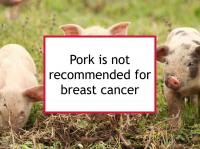Pork is source of CoQ10, niacin (B3), thiamin (B1), vitamin B6 (pyridoxine), and vitamin B12, as well as selenium and zinc. However, pork fat has high saturated fatty acid and cholesterol content. Diets high in pork have been linked to higher risks of esophageal, thyroid, lung, pancreatic, liver, bladder, colorectal, and prostate cancer, among others.
Breast cancer-related effects of eating pork
In this webpage, we evaluate the potential impact on breast cancer risk of consuming pork products that are not salted, smoked or cured. Such pork products are covered under bacon. Breast cancer risk has been found to increase with increasing consumption of pork in several population studies. In addition, high red meat consumption during adolescence has been found to be associated with increased risk of premenopausal breast cancer.
A small Brazilian study found that breast cancer risk was sharply higher for women who regularly consumed lard (rendered pig fat) and fatty red meat. A diet high in lard has been shown to increase mammary tumor incidence and size in a mouse model of triple negative (ER-/PR-/HER2-) breast cancer. One 2025 study reported that different dietary fats can have varying effects on the immune system and tumor growth in obese mice. Lard has the potential to degrade immune cell functioning within the tumor microenvironment by creating lipid intermediates that function as harmful immunosuppressive metabolites.
Red meat intake has been shown reduce circulating melatonin. Melatonin protects against breast cancer in several ways, including by reducing aromatase activity within the breast, thereby decreasing estrogen production.
High intake of saturated fat from animal sources, including pork, has also been found to be associated with increased risk of breast cancer.
Canned meat (e.g., canned ham, spam, or Vienna sausages) can be a significant source of exposure to the breast carcinogen bisphenol A (BPA).
Relatively high levels of heterocyclic aromatic amines (HCAs) have been found in pork dishes such as pork chops and other pan-fried pork, Chinese-style and Western-style roasted pork, pork ribs, and barbecued pork, as well as pork drippings. HCAs have been shown be associated with the development of various cancers, including breast cancer. Two of the HCAs found in pork cooked using high temperature methods, 2-amino-3-methylimidazo[4,5-b]pyridine and 2-amino-1-methyl-6-phenylimidazo[4,5-b]pyridine, have also been shown to have potent estrogenic activity, inducing activation of estrogen-regulated genes, proliferation of estrogen-dependent cells and up-regulation of progesterone receptor.
While iron deficiency anemia is a serious condition to be avoided, the contribution of significant iron in the diet as a result of regularly consuming pork could be detrimental for some women. Pork contains 30 to 60 percent of the iron in beef, depending on the cut. Iron depletion has been shown to lead to significant inhibition of breast cancer cell growth in the laboratory. Relatively high levels of iron in benign breast tissue was found in one prospective study to be associated with an increase in risk of subsequent breast cancer. Other studies have found high levels of iron in the blood to be associated with increased breast cancer risk. Excess iron can interfere with the treatment effects of the chemotherapy drug doxorubicin. High iron intake can also increase the risk of heart damage from treatment with trastuzumab or anthracyclines such as doxorubicin.
In addition, pork livers and kidneys incorporate substantial levels of copper, which could contribute to angiogenesis and metastasis of breast cancer, especially in in aggressive forms of breast cancer such as inflammatory breast cancer (IBC), triple negative, or HER2 overexpressing (HER2+) disease. While copper is a vital nutrient, women with breast cancer who are not anemic probably should not exceed the RDA (recommended daily allowance) of approximately 0.9 mg.
Bottom line
Based on the available evidence, pork prepared using high temperature methods (roasting, barbecuing, deep frying), pork drippings (and gravy made with pork drippings), charred pork, pork fat, and lard all should be limited or avoided by breast cancer patients, survivors and those at high risk for breast cancer. Consumption of lean pork dishes prepared using lower temperature methods should also be limited.
Additional comments
Pork should eaten fully cooked, not rare or raw, to minimize the risk of trichinosis and listeriosis infections.
The USDA forbids the use of hormones in raising swine. Therefore, "no hormone" claims such as Raised Without Added Hormones, No Added Hormones Administered, or Raised Without Steroids are not meaningful.
Lard is used in some processed foods such as baked goods, often in hydrogenated form.
Sources of information in this webpage
The information above, which is updated continually as new research becomes available, has been developed based solely on the results of academic studies. Clicking on any of the underlined terms will take you to its tag or webpage, which contain more extensive information.
Below are links to 20 recent studies concerning this food and its components. For a more complete list, including less recent studies, please click on pork.
